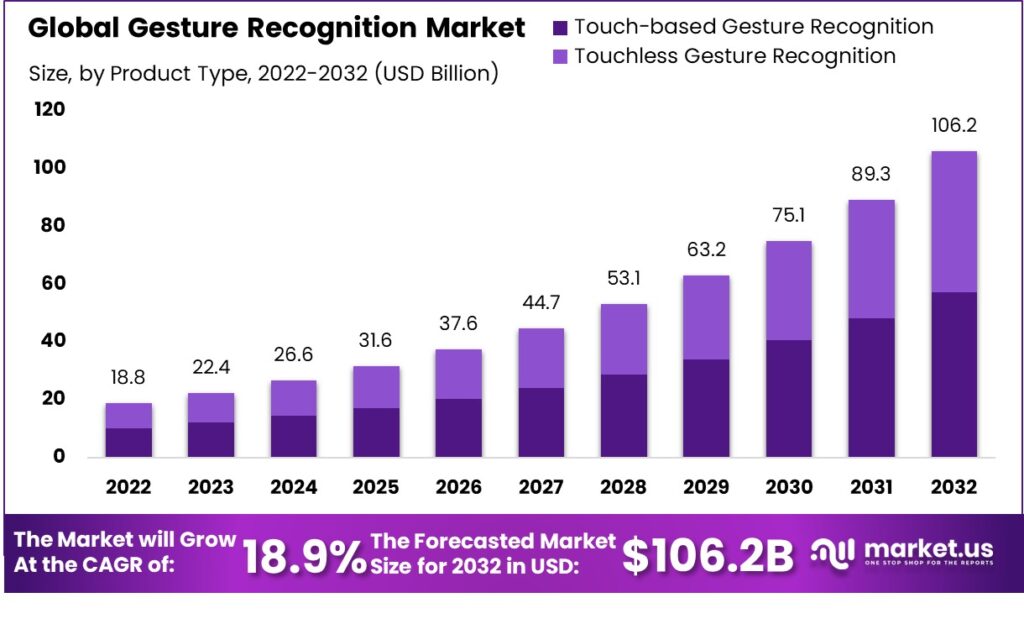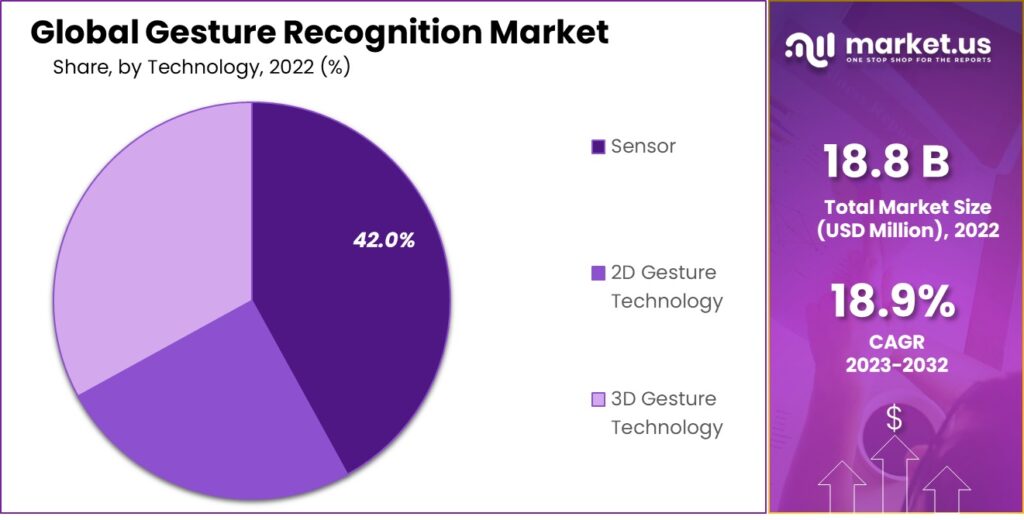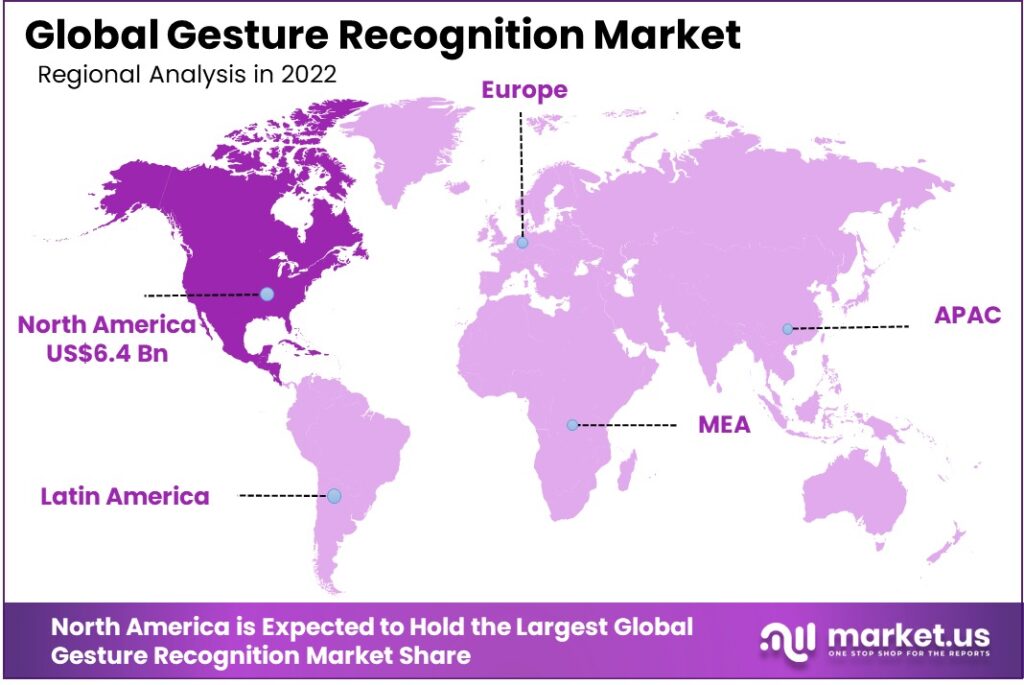Global Gesture Recognition Market By Product Type (Touch-based Gesture Recognition, Touchless Gesture Recognition), By Technology (Sensor, 2D Gesture Technology, 3D Gesture Technology), By End-User (Consumer Electronics, Automotive, Healthcare, Aerospace and Defense, and Other End-Users), By Region and Companies - Industry Segment Outlook, Market Assessment, Competition Scenario, Trends and Forecast 2023-2032
- Published date: Oct. 2023
- Report ID: 32876
- Number of Pages: 366
- Format:
- keyboard_arrow_up
Quick Navigation
Report Overview
The Global Gesture Recognition Market size is expected to be worth around USD 106.2 Bn by 2032 from USD 18.8 Bn in 2022, growing at a CAGR of 18.9% during the forecast period from 2023 to 2032.
Gesture recognition, in its essence, is the process of capturing, analyzing, and interpreting human gestures to perform specific actions or commands on electronic devices or systems. These gestures include hand movements, facial expressions, body postures, and even eye movements. The technology employs hardware and software components to accurately detect and decipher these gestures. The market has witnessed significant growth in recent years and is projected to continue its upward trajectory.
Major factors contributing to this growth include the increasing integration of gesture recognition technology in smartphones, tablets, gaming consoles, and other consumer electronics. The demand for touchless and contactless interfaces, driven by hygiene concerns in a post-pandemic world, has also boosted the adoption of gesture recognition solutions.

Note: Actual Numbers Might Vary In The Final Report
Key Takeaways
- The global gesture recognition market is projected to grow from USD 18.8 billion in 2022.
- The growth of the gesture recognition market is being driven by the increasing adoption of touchless systems in various industries, such as healthcare, automotive, and consumer electronics.
- Touch-based gesture recognition dominated the technology segment in 2022 with the largest revenue share of 0%.
- The sensor segment leads the technology segment by accounting for a revenue share of 42.0% in 2022.
- Consumer electronics are expected to dominate the end-user segment, with a revenue share of 57.5% throughout the forecast period.
- The North America region is anticipated to witness the highest growth, with a revenue share of 34.5% during the projected period.
- The market is also being driven by the development of new technologies, such as deep learning and machine learning, which are improving the accuracy and robustness of gesture recognition systems.
- The key players in the gesture recognition market are Microsoft Corporation, IBM Corporation, Digital Asset Holdings, LLC BTL Group Ltd., The Linux Foundation, Deloitte Touche Tohmatsu Ltd., Global Arena Holding, Inc., Oracle Corporation, Ripple, Circle Internet Financial Limited and Other Key Players
- The major application areas of gesture recognition systems are healthcare, automotive, consumer electronics, gaming, and aerospace and defense.
Driving Factors
Increasing Adoption of Smart Devices
The rapid adoption of smart devices, including smartphones, tablets and smart TVs, is a primary driver behind the market’s growth. With an expanding user base and the demand for enhanced user experiences, gesture recognition technology has become pivotal. In a post-pandemic world, touchless interfaces are increasingly sought after, aligning with the growing focus on hygiene. Integration of gesture recognition in consumer electronics, such as smartphones and smart TVs, empowers users with intuitive and touchless control options. At the same time, its presence in wearables and IoT devices further extends its reach. As smart devices evolve, gesture recognition remains a key element in redefining and improving how we interact with technology, fostering innovation and competitiveness in the market.
Advancements in Artificial Intelligence and Computer Vision
Advancements in Artificial Intelligence (AI) and Computer Vision are fueling the market’s growth by significantly enhancing the accuracy and versatility of gesture recognition systems. AI-driven algorithms continuously improve gesture interpretation, adapt to diverse movements, and learn from user interactions, resulting in highly precise and user-friendly interfaces. Computer Vision technology enables real-time identification of intricate gestures, including facial expressions and eye movements, expanding the scope of recognized gestures.
These advancements foster the development of intuitive user interfaces, support gesture prediction based on context, and personalize interactions, thus enhancing usability and satisfaction. Moreover, AI and Computer Vision facilitate efficient data processing, making real-time recognition feasible in resource-intensive applications like virtual and augmented reality. As these technologies find widespread integration across industries, from consumer electronics to healthcare and automotive, they drive innovation, providing a competitive edge and shaping the future of human-computer interaction.
Restraining Factors
Technical Limitations and Accuracy Issues
Gesture recognition technology, while advancing rapidly, grapples with technical limitations and accuracy issues that can impact its effectiveness and user experience. Environmental factors such as lighting variations, background clutter, and obstructions can hinder accurate recognition, posing challenges for real-world applications. Complex or nuanced gestures may be less reliably interpreted, and noise or interference from other sources can disrupt recognition. Adapting to individual user preferences and accommodating varying distances and depth perception add complexity. Handling occlusion, achieving real-time processing, and addressing multimodal interaction further test the technology’s capabilities.
Privacy and Security Concerns
While promising in its applications, gesture recognition technology gives rise to significant privacy and security concerns that demand comprehensive scrutiny. These concerns include collecting and storing visual data, inadvertent user identification, data security vulnerabilities, and informed consent and transparency issues. The potential for unauthorized access, data sharing with third parties, and the ethical implications of biased recognition algorithms further exacerbate these concerns. Additionally, the risk of spoofing attacks and the complexities of navigating evolving legal and compliance frameworks add to the challenges. Striking a balance between the innovation and convenience gesture recognition offers and safeguarding user privacy and data security remains pivotal for this technology’s responsible and ethical advancement.
Geopolitical Analysis
Trade Disputes Between Countries Like The United States And China May Affect Market Growth
Geopolitical tensions and trade disputes between major players like the United States and China have far-reaching effects on the gesture recognition market. Restrictions on exporting certain technology components can disrupt supply chains and impact manufacturers’ ability to produce gesture-recognition devices. Companies must navigate these trade dynamics to ensure a stable supply of critical components.
By Product Type Analysis
Touch-Based Gesture Recognition is Witnessing The Highest Demand.
The touch-based gesture recognition segment dominated the market in 2022 with the largest revenue share of 54.0%. The demand for touch-based gesture recognition is surging due to its intuitive and user-friendly interface, particularly in a post-pandemic world where hygiene and safety are paramount. It offers an enhanced user experience by enabling natural interactions with digital content, fostering inclusivity for individuals with disabilities. Touch-based gesture recognition finds applications across diverse sectors, from automotive and healthcare to gaming and IoT, further driving its adoption.
Also, touchless gesture recognition is expected to grow highly over the forecasted period. The demand for touchless gesture recognition is fueled by its contributions to hygiene and safety, its extensive use in healthcare, its applications in public spaces and kiosks, accessibility benefits, enhanced user experiences, integration into consumer electronics and IoT, its role in retail and advertising, alignment with future technologies, and its potential to enhance privacy and security.
By Technology Analysis
The Payment Segment Dominates The Market.
The Sensor segment leads the technology segment by accounting for a revenue share of 42.0% in 2022. Sensor technology is most commonly used in Gesture Recognition due to its precision, real-time feedback, versatility, non-intrusiveness, compatibility with diverse environments, scalability, cost-effectiveness, user-friendliness, reduced physical fatigue, integration with emerging technologies, and broad applicability across industries. These advantages make sensor-based gesture recognition robust and reliable for enabling natural and intuitive human-computer interactions.
Furthermore, the 3D gesture technology segment will likely witness high growth over the forecast period. The demand for 3D gesture technology is driven by its ability to enhance user experiences, provide natural and touchless interaction, promote accessibility and inclusivity, find applications in various industries, including automotive, healthcare, and retail, and align with emerging technologies and future applications. These factors collectively contribute to the growing adoption and demand for 3D gesture recognition technology.

Note: Actual Numbers Might Vary In The Final Report
By End-User Analysis
Consumer Electronics are Major End-Users
Consumer electronics are expected to dominate the market with a revenue share of 57.5% throughout the forecast period. The demand for gesture recognition in consumer electronics is surging as it enhances user experiences, offers touchless interaction for safety, fosters innovation and competitiveness, supports accessibility, powers immersive gaming, integrates with IoT, advances technologically, and provides cross-platform versatility, making it a highly sought-after feature in devices like smartphones, smart TVs, and gaming consoles.
Moreover, the healthcare segment will likely experience high growth during the projection period. Gesture recognition is in high demand in healthcare for its touchless operation, promoting hygiene and patient safety, streamlining workflows, enhancing accessibility for patients with limited mobility, and facilitating remote monitoring and telemedicine. It finds applications in surgical procedures, rehabilitation, training, and education, driving its importance in healthcare as it continually advances and improves patient care and medical practices.
Opportunity
Key Opportunities in the Automotive Sector
Gesture recognition technology presents a compelling growth opportunity within the automotive industry, revolutionizing how drivers and passengers interact with vehicles. Its applications span diverse areas, including touchless control of infotainment systems and safety features, personalization for a tailored driving experience, enhanced driver monitoring for safety, and integration with autonomous vehicles. Additionally, gesture recognition aligns with the demand for touchless interfaces in a post-pandemic world, offers improved user experiences, and provides a unique selling point for automakers seeking differentiation. As the automotive sector continues evolving with rapid technological advancements, gesture recognition is a key player in shaping the future of in-car interactions and driving experiences.
Trends
Integration of Gesture Recognition Technology With IoT
Integrating gesture recognition technology with the Internet of Things (IoT) transforms human-computer interactions across diverse industries. It enables touchless control of IoT devices, simplifies device management, and enhances the user experience, creating more intuitive and responsive interactions. Gesture recognition in IoT contributes to energy efficiency, inclusivity for individuals with disabilities, and contextual awareness in smart homes and industrial settings. It also finds applications in healthcare, entertainment, automotive IoT, security, and surveillance. Additionally, the data collected from gesture recognition in IoT can inform product design and marketing strategies, driving innovation and efficiency in the connected world.
Key Market Segments
Product Type
- Touch-based Gesture Recognition
- Touchless Gesture Recognition
Technology
- Sensor
- 2D Gesture Technology
- 3D Gesture Technology
End-User
- Consumer Electronics
- Automotive
- Healthcare
- Aerospace and Defense
- Other End-Users
Regional Analysis
North America dominates the market by holding a significant revenue share.
The North America region is anticipated to witness the highest growth, with a revenue share of 34.5% during the projected period. The region, known for its technological prowess, spearheads advancements in sensors, cameras, and machine learning algorithms, driving the adoption of gesture recognition in consumer electronics, particularly smartphones, smart TVs, and gaming consoles. The automotive sector sees the integration of gesture-based control systems for enhanced infotainment and safety features, while healthcare applications, including touchless medical equipment control and telemedicine solutions, flourish.
North America’s prominence in the entertainment and gaming industries elevates gesture recognition’s role in creating immersive experiences. Increased investments, robust infrastructure, regulatory support, a commitment to enhancing user experiences, and a focus on accessibility contribute to North America’s position as a thriving hub for gesture recognition technology innovation and adoption.
Asia Pacific region is growing thanks to rapid tech adoption, a growing consumer electronics sector, an expanding automotive industry, smart city initiatives, healthcare and education adoption, cultural affinity for gesture-based communication, a robust manufacturing and tech hub, accessibility goals, and government support for innovation. These diverse factors make Asia Pacific a dynamic and promising market for gesture recognition technology.

Note: Actual Numbers Might Vary In The Final Report
Key Regions and Countries
- North America
- The US
- Canada
- Europe
- Germany
- France
- The UK
- Spain
- Italy
- Russia
- Netherlands
- Rest of Europe
- APAC
- China
- Japan
- South Korea
- India
- Australia
- New Zealand
- Singapore
- Thailand
- Vietnam
- Rest of APAC
- Latin America
- Brazil
- Mexico
- Rest of Latin America
- Middle East & Africa
- South Africa
- Saudi Arabia
- UAE
- Rest of MEA
The market is characterized by a competitive landscape, including tech giants like Microsoft, Google, and Apple, sensor manufacturers such as Qualcomm and Intel, innovative startups like Leap Motion and Ultraleap, automotive suppliers like Continental AG and Harman International, healthcare technology providers like NUIA and GestSure, gaming and entertainment companies, AI developers, IoT device manufacturers, EdTech firms, industrial and robotics players, and security and surveillance specialists. This diverse array of competitors drives innovation and adoption across various industries and applications.
Top Key Players in the Global Gesture Recognition Market
- Apple Inc.
- Microsoft Corporation
- Infineon Technologies AG
- Omek Interactive Ltd
- Microchip Technology Incorporated
- NXP Semiconductors
- Samsung Electronics Co., Ltd.
- Sony Corporation
- Intel Corporation
- Qualcomm Technologies, Inc.
- Texas Instruments Incorporated
- Omnivision Technologies, Inc.
- Other Key Players
Recent Developments
- In August 2022, a radar technology startup from Bengaluru, Steradian Semiconductors Private Limited, agreed to be acquired by Renesas Electronics Corporation, a well-known semiconductor firm. This acquisition is set to broaden Renesas’ range of Human-Machine Interface (HMI) products, which includes gesture recognition technology.
- In September 2021, Alcatraz AI, a firm specializing in physical security technology solutions, introduced a new authentication solution called “the Rock.” This cutting-edge innovation is designed to minimize the need for physical touch interactions. It offers a means to confirm the identity of individuals even when they are wearing face masks, thereby boosting the safety of employees amid the COVID-19 pandemic.
Report Scope
Report Features Description Market Value (2022) USD 18.8 Bn Forecast Revenue (2032) USD 106.2 Bn CAGR (2023-2032) 18.9% Base Year for Estimation 2022 Historic Period 2016-2022 Forecast Period 2023-2032 Report Coverage Revenue Forecast, Market Dynamics, COVID-19 Impact, Competitive Landscape, Recent Developments Segments Covered By Product Type (Touch-based Gesture Recognition, Touchless Gesture Recognition), By Technology (Sensor, 2D Gesture Technology, 3D Gesture Technology), By End-User (Consumer Electronics, Automotive, Healthcare, Aerospace and Defense, and Other End-Users) Regional Analysis North America – The US & Canada; Europe – Germany, France, The UK, Spain, Italy, Russia, Netherlands, and Rest of Europe; APAC- China, Japan, South Korea, India, Australia, New Zealand, Singapore, Thailand, Vietnam, and Rest of APAC; Latin America- Brazil, Mexico & Rest of Latin America; Middle East & Africa- South Africa, Saudi Arabia, UAE & Rest of MEA Competitive Landscape Microsoft Corporation, IBM Corporation, Digital Asset Holdings, LLC BTL Group Ltd., The Linux Foundation, Deloitte Touche Tohmatsu Ltd., Global Arena Holding, Inc., Oracle Corporation, Ripple, Circle Internet Financial Limited and Other Key Players Customization Scope Customization for segments, region/country-level will be provided. Moreover, additional customization can be done based on the requirements. Purchase Options We have three licenses to opt for: Single User License, Multi-User License (Up to 5 Users), Corporate Use License (Unlimited User and Printable PDF) Frequently Asked Questions (FAQ)
What is gesture recognition?Gesture recognition is the technology of interpreting human gestures and movements into commands for a machine. It is used to control devices without touching them, such as smartphones, tablets, and computers.
How does gesture recognition work?Gesture recognition works by capturing the user's gestures and movements using sensors, such as cameras, infrared sensors, and depth sensors. The captured data is then processed by a computer algorithm to recognize the gestures.
What are the different types of gesture recognition?There are two main types of gesture recognition: touch-based gesture recognition and touchless gesture recognition. Touch-based gesture recognition uses sensors on a device to detect the user's gestures. Touchless gesture recognition uses sensors to detect the user's gestures in the air.
What are the advantages of using gesture recognition in technology?Gesture recognition offers a more intuitive and natural way of interacting with devices and systems. It can enhance user experience, improve accessibility, and enable touchless control, which is valuable in hygiene-sensitive environments.
What companies are leading the gesture recognition market?Several companies are active in the gesture recognition market, including Microsoft Corporation, IBM Corporation, Digital Asset Holdings, LLC BTL Group Ltd., The Linux Foundation, Deloitte Touche Tohmatsu Ltd., Global Arena Holding, Inc., Oracle Corporation, Ripple, Circle Internet Financial Limited and Other Key Players
 Gesture Recognition MarketPublished date: Oct. 2023add_shopping_cartBuy Now get_appDownload Sample
Gesture Recognition MarketPublished date: Oct. 2023add_shopping_cartBuy Now get_appDownload Sample - Apple Inc. Company Profile
- Microsoft Corporation Company Profile
- Infineon Technologies AG
- Omek Interactive Ltd
- Microchip Technology Incorporated
- NXP Semiconductors
- Samsung Electronics Co., Ltd.
- Sony Corporation
- Intel Corporation
- Qualcomm Technologies, Inc.
- Texas Instruments Incorporated
- Omnivision Technologies, Inc.
- Other Key Players
- settingsSettings
Our Clients
| Single User $4,599 $3,499 USD / per unit save 24% | Multi User $5,999 $4,299 USD / per unit save 28% | Corporate User $7,299 $4,999 USD / per unit save 32% | |
|---|---|---|---|
| e-Access | |||
| Report Library Access | |||
| Data Set (Excel) | |||
| Company Profile Library Access | |||
| Interactive Dashboard | |||
| Free Custumization | No | up to 10 hrs work | up to 30 hrs work |
| Accessibility | 1 User | 2-5 User | Unlimited |
| Analyst Support | up to 20 hrs | up to 40 hrs | up to 50 hrs |
| Benefit | Up to 20% off on next purchase | Up to 25% off on next purchase | Up to 30% off on next purchase |
| Buy Now ($ 3,499) | Buy Now ($ 4,299) | Buy Now ($ 4,999) |















